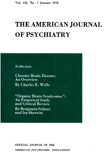HOMOSEXUALITY AND PARANOID SCHIZOPHRENIA : A SURVEY OF 150 CASES AND CONTROLS
Abstract
In this paper, the data obtained from a study of the records of 150 paranoid schizophrenic patients and a control group of 150 non-psychotic patients were presented and discussed in relation to Freud's hypothesis concerning the development of paranoid symptoms. Four consequences of Freud's hypothesis were deduced. Three of the deduced consequences received strong verification from the study, the differences between the paranoid psychotic and control groups being found very significant. The fourth consequence, that we should expect the final delusions and hallucinations of the paranoid group to have prominent sexual content, did not receive verification from the study. Comparison with the control group here was impossible due to the absence of delusions in the control group.
Another point needs to be mentioned concerning the present study. This is the fact that two trends may exist together in a personality and yet not necessarily be related. Bleuler originally brought up this point in commenting that homosexuality was very prominent in Schreber's case history, but may not have been the determining factor in the paranoid illness. While the present study, within its limits, lends strong verification to three consequences of Freud's theory, it is possible that future investigation may show the coexistence of the two trends of paranoia and homosexuality to be a coincidental finding.
Few psychiatrists dispute that Freud's fecund intelligence was productive of many theories that have deepened our knowledge of psychological functioning. But, it is also a logical fallacy to argue that a theory is verified because it explains certain facts.
The process of verification, as utilized in this paper, is the same method used by the vast majority of scientific investigators. We feel that the following studies of this important subject are needed:
1. Studies of the relationship of homosexuality to paranoid schizophrenia in female groups, as compared with control groups. As noted in the literature review, there are only two nonpsychoanalytic case reports dealing with homosexuality and paranoid schizophrenia in females.
2. Studies on this subject utilizing primary source material. A protocol should be drawn up in advance, including definition of terms and categories to be recorded. This protocol should be used in interviewing a random sampling of paranoid schizophrenic patients, and a similar group of non-psychotic patients of varying diagnoses. Other control groups may also be used. The examiners should be free of preconceived opinions regarding the relationship of homosexuality to the paranoid schizophrenic process.
Until more scientific studies are made and analyzed, the hypothesis that paranoid psychotic symptoms develop as a defense against emerging unconscious homosexual wishes cannot be regarded as verified.
Access content
To read the fulltext, please use one of the options below to sign in or purchase access.- Personal login
- Institutional Login
- Sign in via OpenAthens
- Register for access
-
Please login/register if you wish to pair your device and check access availability.
Not a subscriber?
PsychiatryOnline subscription options offer access to the DSM-5 library, books, journals, CME, and patient resources. This all-in-one virtual library provides psychiatrists and mental health professionals with key resources for diagnosis, treatment, research, and professional development.
Need more help? PsychiatryOnline Customer Service may be reached by emailing [email protected] or by calling 800-368-5777 (in the U.S.) or 703-907-7322 (outside the U.S.).



